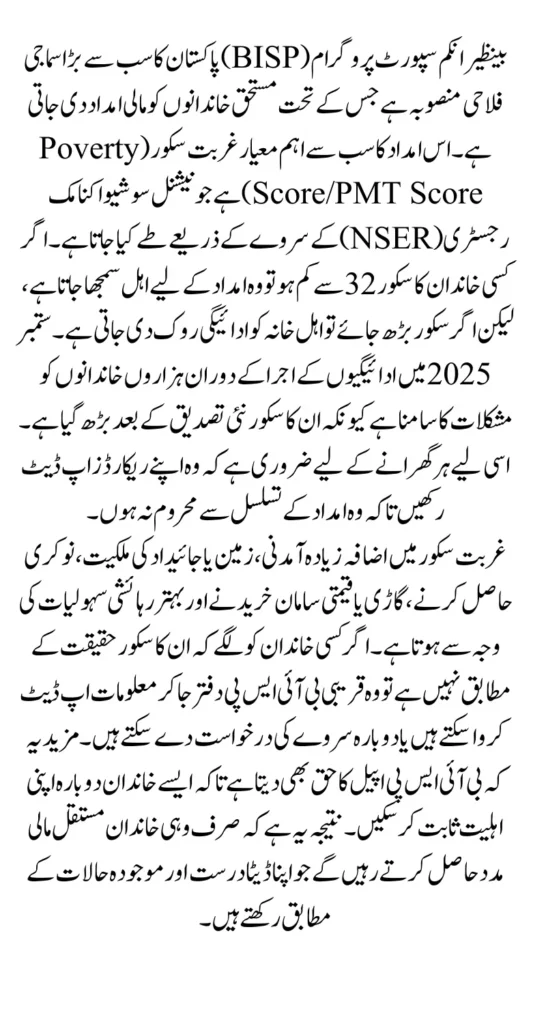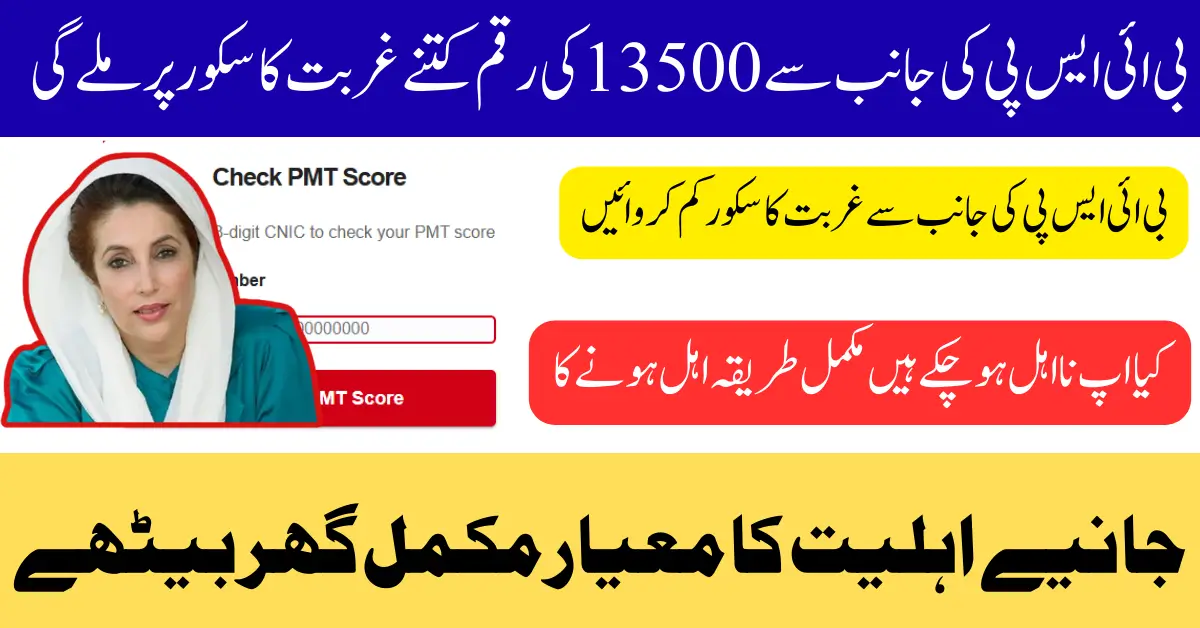BISP Poverty Score 2025
BISP Poverty Score 2025 continues to play a vital role in supporting low-income families across Pakistan. As of September 2025, the focus has shifted strongly towards the Poverty Score (PMT Score), which is the deciding factor for both new applicants and existing beneficiaries. This score determines who will receive quarterly payments and who may face disqualification. Families with low scores are considered deserving, while those with higher scores may lose access to assistance.

To secure your eligibility and ensure smooth payments, it is important to fully understand how the Poverty Score works, how it affects approvals, and what steps you can take if your payments are stopped.
You Can Also Read: BISP 8171 New Updates 2025 – Check Eligibility
Overview What the Poverty Score (PMT) Means
The Poverty Score, also known as the PMT Score (Proxy Means Test), is assigned to every household based on a nationwide survey conducted under the National Socio-Economic Registry (NSER). This score is generated by analyzing details about a family’s income, employment, property ownership, and overall living conditions.
A lower PMT score indicates that a household is struggling financially and qualifies for cash support, while a higher score signals relative financial stability and reduces the chances of assistance. In simple terms:
- Low score = More chances of eligibility
- High score = Higher risk of removal from the program
This transparent method ensures that BISP funds are targeted towards the most vulnerable families who genuinely need support.
Why the Poverty Score Matters in September 2025
September 2025 is an especially important month for BISP beneficiaries, as the quarterly payments are being released nationwide. However, thousands of households are facing delays or disqualifications because their poverty scores have recently changed after re-verification. The government has tightened the monitoring process, which means families with scores higher than the acceptable range are being removed from the beneficiary list.
- Families with scores below 32 are considered eligible.
- Families with scores above 32 are at high risk of disqualification.
- Households close to the borderline often face longer verification delays.
This makes it essential for every applicant to track their Poverty Score and take timely action if there are errors or changes.
You Can Also Read: CM Punjab Free Livestock Program 2025 September
Eligibility Snapshot (Thresholds You Should Know)
The following table gives a quick snapshot of the Poverty Score and its effect on BISP eligibility:
| Poverty Score Range | Eligibility Status | Payment Chance |
|---|---|---|
| Below 32 | Eligible | High |
| Around 32 | Under Review | Possible Delay |
| Above 32 | At Risk | Low |
This simple framework allows families to check where they stand and what they should expect during payment release cycles.
You Can Also Read: BISP 8171 Web Portal Guide 2025 To Check Newly Registered Women
How Your Score Is Calculated (Key Signals the System Reads)
Your PMT score is based on various indicators that reflect your family’s lifestyle and financial status. The NSER survey collects household-level data and assigns a number according to your circumstances. Some of the main factors include:
- Household Income → The higher your monthly income, the higher your score.
- Assets and Property → Owning land, a house, or other property increases your score.
- Employment Type → Working in formal government or private jobs adds points to your score.
- Lifestyle Conditions → House size, use of electric appliances, or owning a vehicle also affect the calculation.
This process makes sure that financial assistance goes only to those who are in genuine need and cannot afford a stable living without government support.
You Can Also Read: 8171 Portal 2025 To Check Recent Release 13500 Payment
Where the Score Decides Your Case
The Poverty Score is not just a number—it actively decides whether your family will continue to receive cash assistance or not. It impacts the following stages:
1. Initial Registration
When you first apply for BISP 8171, your NSER survey generates a Poverty Score that immediately decides whether your application is approved. Families with a score below 32 are usually accepted.
2. Payment Continuity
Even if you were eligible in the past, your payments may stop if your score increases during updated surveys. This is why updating your household information is crucial.
3. Re-Verification
The government regularly re-checks NSER records. If your income, property, or lifestyle has improved, your score will rise, and your payments may be discontinued.
BISP September 2025 Payment Checklist (Avoid Delays)
To ensure that you receive your September 2025 installment without any delay, make sure that:
- Your poverty score is still within the eligible range.
- Your CNIC is valid and updated with NADRA records.
- Your mobile number is registered to receive 8171 SMS notifications.
Families who miss any of these requirements often face payment interruptions. Keeping documents updated helps in avoiding delays during the disbursement period.
Common Reasons Scores Go Up (And Trigger Stops)
Many households are surprised when their Poverty Score rises unexpectedly. The main reasons for an increased score include:
- Increase in monthly income or salary.
- Ownership or purchase of land, property, or houses.
- Employment in a government or private sector job.
- Purchase of vehicles or luxury items.
- Improved living standards such as big houses or modern appliances.
These changes signal better financial stability, which is why the government reduces support for such families.
Fixing Score-Related Issues Fastest Paths
If you believe your score does not reflect your real financial condition, there are clear steps to correct it:
- Update Household Data
Visit your nearest BISP Tehsil Office and correct any outdated information in the system. - Request Re-Survey
Families can apply for a new NSER survey, which allows a fresh evaluation of their situation. Many households have regained eligibility through this process. - Appeal for Review
If your payments were stopped unfairly, you can file an official appeal. This allows the authorities to re-examine your case.
How to Check Your Poverty Score Status
It is very easy to check your Poverty Score and confirm whether you are eligible for BISP payments:
- SMS Service → Send your CNIC number to 8171 and get an instant response.
- Web Portal → Visit the 8171 online portal, enter your CNIC, and check your details.
- BISP Tehsil Office → Visit physically to get complete details and official guidance.
This ensures that you stay informed about your payment status at all times.
You Can Also Read: BISP Survey 2025 Payment Eligibility And September 13500
Borderline Scores What to Expect
Households with scores very close to 32 are often placed under extra verification. This can cause delays in payments as authorities carefully re-check their financial situation. In such cases, you should:
- Keep all important documents ready, including CNIC and income proof.
- Regularly monitor updates through the 8171 SMS system.
- Visit the nearest Tehsil Office if your payment is pending for a long time.
Stay Eligible Smart Habits
To make sure you remain a part of the program for the long term, it is important to adopt certain habits:
- Keep your CNIC updated with NADRA at all times.
- Provide accurate information during NSER surveys.
- Report any changes in family size or income quickly.
- Regularly check your status through the 8171 service.
By following these steps, you can maintain eligibility and avoid sudden payment suspensions.
Looking Ahead Modernization of the PMT System
The government is modernizing the Poverty Score system using advanced digital tools and data integration. This will make the system more transparent, reduce fraud, and ensure that only genuine families remain in the program.
Future updates may include:
- Automated checks with real-time data.
- Stronger cross-verification with NADRA and tax records.
- Faster approvals and fewer delays for deserving households.
This means beneficiaries must always keep their information accurate to avoid issues in upcoming re-verifications.
You Can Also Read: 8171 Portal 2025 To Check Recent Release 13500
Key Takeaways
The BISP Poverty Score 2025 is the deciding factor for families waiting for September payments. If your score is below 32, you are likely safe and eligible. However, scores above 32 place you at risk of disqualification. Families should always keep their CNICs updated, check eligibility via 8171, and immediately correct errors in their records.
By understanding, tracking, and managing the Poverty Score, you can secure your place in the BISP 8171 payment system and ensure your family continues to receive financial assistance in the months ahead.
FAQs
Q1: What is the minimum Poverty Score required for BISP eligibility?
Families with a score below 32 are generally eligible to receive financial assistance under BISP.
Q2: Can I still get payments if my score is 32 or slightly above?
Yes, but your case may go under extra verification. Families around the borderline often face payment delays until their data is re-checked.
Q3: Why did my payments stop even though I was getting them before?
Your Poverty Score may have increased after a new NSER verification. This usually happens if your income rose, you bought property, or improved your lifestyle indicators.
Q4: How can I check my Poverty Score status?
You can send your CNIC to 8171, use the 8171 web portal, or visit the nearest BISP Tehsil Office.
Q5: Is there a way to lower my Poverty Score?
Yes, but only if your current score is based on outdated or incorrect information. You can request a re-survey or update your household records at the BISP office.
Q6: Can I reapply if I have been removed from the program?
Yes, you can reapply through an NSER survey or by submitting an appeal for review if your financial situation has changed.
Final Words
The BISP Poverty Score 2025 has become the central factor in determining whether families receive quarterly payments in September 2025. By keeping your records updated, monitoring your score, and understanding the eligibility threshold, you can secure your payments and avoid disqualification. Payments are not permanent; they depend on your current Poverty Score. Regular re-verifications ensure only the most deserving households remain in the system. Acting quickly through re-surveys or appeals can help restore payments if they stop unexpectedly.
In short, the Poverty Score is more than just a number—it is the key to financial support under BISP 8171. By staying informed and proactive, families can continue to benefit from the program and safeguard their financial stability.


